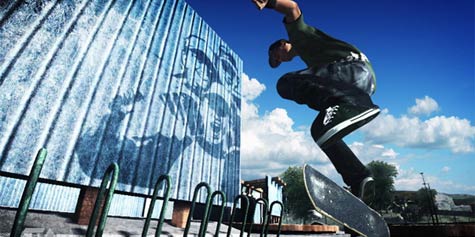
I’ve written about Skate before, in the context of designing online games for a generation of players used to a world where they are in control, and where everything is shareable. Writing last year, I said:
I find Skate exciting because it’s a prime example of a game that understands Generation C; it allows players to share game-information outside the game – and in a manner that is so much more easily referenced, due to it having a permanent link – just as they share movies, photos, and blogposts.
The original Skate had an impressive community website, for sharing screengrabs and videos. It wasn’t without faults, though – it was very difficult to permalink to, as every request to Reel (the video-sharing community) first asked you what country you were in, and then redirected you to a homepage, rendering the permalink useless.
How refreshing, then, to see the improvements made to the new Reel site for Skate 2, released at the beginning of this year. Now, permalinks are encouraged – here’s an example – but the concessions to creative end-users go several steps further.
Once you’ve uploaded a video, Reel not only lets you view it and share it with friends, but also now provides proper good embed code, making it trivially easy to re-contextualise the video on your own site. Even more remarkably, though, Reel allows you to download the FLV (flash video format) file for the video, so you can upload it somewhere else – Youtube, Flickr, Revver, wherever you store your video. Here’s a video of me skating a short session – just click on it to watch:
They let you download the FLV! That’s brilliant. Because, you see, even though Reel is good, it’s not where my friends are; my friends are on Youtube and Flickr. When the first game was out, smart Skate-rs wanting to upload their videos to Youtube had to rip the FLV file by peeking into the source of the page; now, EA are enabling them to do that licitly. The file is, after all, still watermarked with the Skate 2 logo, still understood as a fragment of that product – so what if somebody wants to tweak it in iMovie or Windows Movie Maker, or cut it into a best-of compilation, or re-upload it to Youtube? They created the content, and so they should be free to do what they want with it.
The web facilitates and encourages this – the FLV file was always present, it was just obfuscated. By adding an explicit download link, EA demonstrate that they understand not only the fact that you want to share your footage, but also the reasons why you might want to share it, and also that they understand their place in the ecology of the web. They’ve provided the hard part: exporting video from a 360 or PS3 to the web. Now, you should be free to do what you want with it.
EA have even released a downloadable pack with more advanced cameras for filming replays – cameras that can track and follow motion-controlled patterns, for instance. Whilst you could argue that this functionality should have been free, it’s interesting to note an add-on for a game that’s about creativity and sharing, rather than gameplay – and more interesting to note that as well as providing more tools, the “filmer pack” also bumps the amount of video you can store online nearly four-fold.
The Reel site for Skate 2 is a great example of the enabling of permanence, and ‘going where people are”, that I discussed in my talks at NLGD and Develop last year. It’s also an interesting example of the kind of social play that’s much more common than simultaneous, co-operative play – namely, the sharing of play experiences around or after the fact; the objects that emerge out of play. That’s something I talked about at Playful last year (and which, I discover, shamelessly isn’t online yet. Will rectify that soon!) As ever, it’s always exciting to see real-world, big-money, examples of good practice in action. And, as a bonus: here’s my profile on Reel.
(I’ve been meaning to write this post for ages, and it’s been sitting in my draft folder for way too long. If in doubt: just release it into the world)

